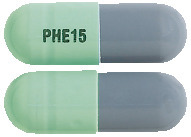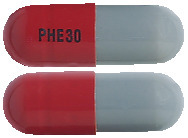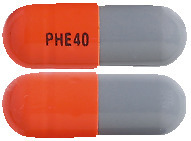SUMMARY CMI
Phentodur
Consumer Medicine Information (CMI) summary
The full CMI on the next page has more details. If you are worried about using this medicine, speak to your doctor or pharmacist.
1. Why am I using Phentodur?
Phentodur contains the active ingredient phentermine. Phentodur is used to reduce body weight in obese or overweight patients. For more information, see Section 1. Why am I using Phentodur? in the full CMI.
2. What should I know before I use Phentodur?
Do not use if you have ever had an allergic reaction to phentermine or any of the ingredients listed at the end of the CMI.
There are a number of circumstances in which a person should not use this medicine or may need to use caution. It is important to understand if these apply to you before taking Phentodur (see the full CMI for more details).
Talk to your doctor if you have any other medical conditions, take any other medicines, or are pregnant or plan to become pregnant or are breastfeeding.
For more information, see Section 2. What should I know before I use Phentodur? in the full CMI.
3. What if I am taking other medicines?
Some medicines may interfere with Phentodur and affect how it works.
A list of these medicines is in Section 3. What if I am taking other medicines? in the full CMI.
4. How do I use Phentodur?
- Carefully follow all directions given by your doctor or other healthcare professionals and never change the dose yourself.
- The usual dose of Phentodur is one capsule a day.
- Swallow the capsule whole with plenty of water. Do not chew or open the capsules.
More instructions can be found in Section 4. How do I use Phentodur? in the full CMI.
5. What should I know while using Phentodur?
| Things you should do |
|
| Things you should not do |
|
| Driving or using machines |
|
| Drinking alcohol |
|
| Looking after your medicine |
|
For more information, see Section 5. What should I know while taking Phentodur? in the full CMI.
6. Are there any side effects?
Common side effects include changes in your heartbeat, high blood pressure, restlessness, trouble sleeping, nervousness, tremor, headache, dizziness, fainting, nausea, vomiting, diarrhoea or constipation, stomach cramps, dry or unpleasant taste in mouth, trouble urinating, skin rashes, sexual function problems, feelings of extreme happiness followed by depression and tiredness.
Serious side effects include heart attack, stroke, chest pain, myocardial infarction and difficulty breathing.
For more information, including what to do if you have any side effects, see Section 6. Are there any side effects? in the full CMI.
FULL CMI
Phentodur
Active ingredient(s): Phentermine (fen-ter-mean)
Consumer Medicine Information (CMI)
This leaflet provides important information about using Phentodur. You should also speak to your doctor or pharmacist if you would like further information or if you have any concerns or questions about taking Phentodur.
Where to find information in this leaflet:
1. Why am I taking Phentodur?
2. What should I know before I take Phentodur?
3. What if I am taking other medicines?
4. How do I take Phentodur?
5. What should I know while taking Phentodur?
6. Are there any side effects?
7. Product details
1. Why am I taking Phentodur?
Phentodur contains the active ingredient phentermine. Phentermine is combined with a resin which slowly releases the phentermine so the effect of Phentodur lasts all day.
Phentodur is used to reduce body weight in obese or overweight patients.
Phentodur is an appetite suppressant that works by directly affecting the area of the brain that controls your appetite making you feel less hungry.
Phentodur should be used as a part of an overall weight management plan, which includes a medically controlled diet and exercise program.
Your doctor will assess whether Phentodur is suitable for you.
2. What should I know before I take Phentodur?
Warnings
Do not use Phentodur if:
- You are allergic to phentermine, or any of the ingredients listed at the end of this leaflet. Always check the ingredients to make sure you can use this medicine. Some of the symptoms of an allergic reaction may include:
- shortness of breath
- wheezing or difficulty breathing
- swelling of the face, lips, tongue, or other parts of the body
- rash, itching or hives on the skin. - You are taking any similar medicines to reduce weight.
- You have any of the following medical conditions:
- very high blood pressure
- high blood pressure in the lungs
- problems with your heart valves
- disease related to blood vessels in the brain
- severe heart disease including changes in the rhythm or rate of the heartbeat
- narrowing of the blood vessels due to thickening or hardening of the blood vessel wall
- overactive thyroid gland
- psychiatric illness including anorexia nervosa (loss of appetite) and depression
- glaucoma (high pressure in the eye). - It is past the expiry date printed on the pack or if the packaging is torn or shows signs of tampering.
- You are a child under the age of 12 years. Safety and effectiveness in children younger than 12 years have not been established.
- You are elderly.
- You are currently taking, or have taken within the last 14 days, antidepressant medicines called mono-amine oxidase inhibitors (MAOIs).
- You have previously misused drugs or alcohol.
Check with your doctor if you:
- Have any other medical conditions including:
- high blood pressure
- heart disease such as angina (chest pain)
- diabetes
- epilepsy - Take any medicines for any other condition.
During treatment, you may be at risk of developing certain side effects. It is important you understand these risks and how to monitor for them. See additional information under Section 6. Are there any side effects?
Pregnancy and breastfeeding
Check with your doctor if you are pregnant or intend to become pregnant.
Talk to your doctor if you are breastfeeding or intend to breastfeed.
3. What if I am taking other medicines?
Tell your doctor or pharmacist if you are taking any other medicines, including any medicines, vitamins or supplements that you buy without a prescription from your pharmacy, supermarket or health food shop.
Some medicines may interfere with Phentodur and affect how it works.
These include:
- other medicines for weight reduction
- medicines for depression or obsessive-compulsive disorder or other mental illness
- ergot-like medicines for migraine
- some cough and cold remedies
- thyroid hormones
- medicines for lowering high blood pressure.
Check with your doctor or pharmacist if you are not sure about what medicines, vitamins or supplements you are taking and if these affect Phentodur.
4. How do I take Phentodur?
How much to take
- The usual dose is one capsule a day, however your doctor will prescribe the right dose for you.
- Swallow the capsules whole with plenty of water. Do not chew or open the capsules.
- Carefully follow the instructions provided and use Phentodur until your doctor tells you to stop.
Increasing the dose may not necessarily make you lose more weight or make you lose weight faster. However, you will more likely experience side effects. Your doctor will tell you how long you are to take Phentodur for.
When to take Phentodur
- Take Phentodur first thing in the morning, at breakfast time so that it does not keep you awake at night.
- Taking Phentodur at the same time each day will have the best effect. It will also help you remember when to take it. It does not matter if you take this medicine before or after food.
- Do not change the dose unless your doctor tells you to do so.
If you forget to use Phentodur
Phentodur should be used regularly at the same time each day. If you miss your dose at breakfast, take it no later than lunchtime.
If you take Phentodur any later than lunchtime you may have trouble sleeping at night.
If it is almost time for your next dose, skip the dose you missed and take your next dose when you are meant to.
Do not take a double dose to make up for the dose you missed.
If you use too much Phentodur
If you think that you have taken too much Phentodur, you may need urgent medical attention.
You should immediately:
- phone the Poisons Information Centre
(by calling 13 11 26 in Australia or 0800 764 766 [0800 POISON] in New Zealand), or - contact your doctor, or
- go to the Emergency Department at your nearest hospital.
You should do this even if there are no signs of discomfort or poisoning.
5. What should I know while taking Phentodur?
Things you should do
- Remind any doctor, dentist or pharmacist you visit that you are taking Phentodur.
- If you are going to have surgery, tell the surgeon or anaesthetist that you are taking Phentodur.
- Check with your doctor or pharmacist before you start to take any cough or cold medication.
Call your doctor straight away if you:
- Become pregnant while taking this medicine.
- Experience sudden or rapid weight loss, difficulty breathing, chest pain, fainting, and swelling of the lower limbs and if you cannot exercise as much as you usually can.
Things you should not do
- Do not take Phentodur to treat any other conditions unless your doctor tells you to.
- Do not give your medicine to anyone else, even if they have the same condition as you.
Driving or using machines
Be careful before you drive or use any machines or tools until you know how Phentodur affects you.
Drinking alcohol
Tell your doctor if you drink alcohol.
Do not drink alcohol whilst taking Phentodur.
Looking after your medicine
Follow the instructions in the carton on how to take care of your medicine properly.
- Keep your capsules in the blister-foil in the carton until it is time to take them.
- Store Phentodur below 30°C in a cool dry place away from moisture, heat, or sunlight; for example, do not store it:
- in the bathroom or near a sink, or
- in the car or on windowsills.
Keep it where young children cannot reach it.
Getting rid of any unwanted medicine
If you no longer need to use this medicine or it is out of date, take it to any pharmacy for safe disposal.
Do not use this medicine after the expiry date.
6. Are there any side effects?
All medicines can have side effects. If you do experience any side effects, most of them are minor and temporary. However, some side effects may need medical attention.
See the information below and, if you need to, ask your doctor or pharmacist if you have any further questions about side effects.
Less serious side effects
| Less serious side effects | What to do |
| Speak to your doctor if you have any of these less serious side effects and they worry you. |
Serious side effects
| Serious side effects | What to do |
| Call your doctor straight away, or go straight to the Emergency Department at your nearest hospital if you notice any of these serious side effects. |
Tell your doctor or pharmacist if you notice anything else that may be making you feel unwell.
Other side effects not listed here may occur in some people.
Reporting side effects
After you have received medical advice for any side effects you experience, you can report side effects to the Therapeutic Goods Administration online at www.tga.gov.au/reporting-problems in Australia, or Medsafe at www.medsafe.govt.nz/safety/report-a-problem.asp in New Zealand.
By reporting side effects, you can help provide more information on the safety of this medicine.
Always make sure you speak to your doctor or pharmacist before you decide to stop taking any of your medicines.
7. Product details
This medicine is only available with a doctor's prescription.
What Phentodur contains
| Active ingredient (main ingredient) | Phentermine |
| Other ingredients (inactive ingredients) | lactose monohydrate liquid paraffin magnesium stearate gelatin titanium dioxide iron oxide black (CI 77499) sodium polystyrene sulfonate In addition: Phentodur 15 mg contains: brilliant blue FCF (CI 42090) iron oxide yellow (CI 77492) Phentodur 30 mg contains: iron oxide red (CI 77491) Phentodur 40 mg contains: erythrosine (CI 45430) sunset yellow FCF (CI 5985) |
| Potential allergens | Contain sugars as lactose monohydrate |
Do not take this medicine if you are allergic to any of these ingredients.
Phentodur capsules are gluten-free.
What Phentodur looks like
Phentodur capsules are available in three strengths in packs of 30 capsules:
15 mg - AUST R 310850
Grey and green and marked PHE 15
30 mg - AUST R 310861
Grey and reddish brown and marked PHE 30
40 mg - AUST R 310863 * (Australia only)
Grey and orange and marked PHE 40
Who distributes Phentodur
Australia
Arrotex Pharmaceuticals Pty Limited
15-17 Chapel St
Cremorne VIC 3121
New Zealand
Pharmacy Retailing (NZ) Ltd trading as Healthcare Logistics
58 Richard Pearse Drive
Airport Oaks
Auckland
This leaflet was prepared in December 2023.
Published by MIMS January 2024





